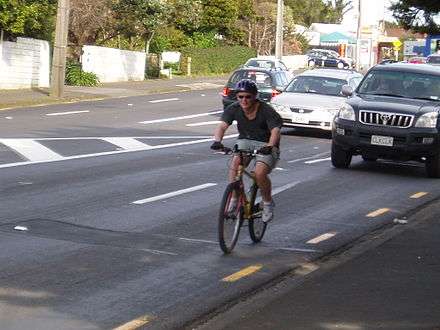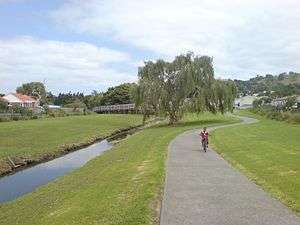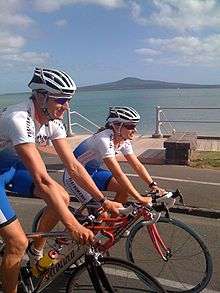Cycling in Auckland

Cycling in Auckland is a mode of transport which has historically had high levels of modal share in Auckland, New Zealand, like in most cities in New Zealand. However, the dominance of the car in the city,[2][3] the negative attitudes of car drivers[4] and general changes in transport patterns have made it a very marginal transport mode as of the early 21st century, with the remaining cyclists often cycling for leisure and sports purposes.
While political and infrastructure initiatives are underway to revive cycling, success is still to be solidified. As of 2005/06, only 16% of the Regional Cycle Network had been completed, which also included routes that had been built before the plan for a regional network had been adopted.[5] In 2014, results showed that cycling mode share had stopped declining compared to previous census results, though from 0.9% in 2006, it had only risen to 1.2% of all work trips on census day.[6] However, statistics and automatic counters show the success of cycling where higher-quality infrastructure has been installed, with nine counters across Auckland reporting annual cycle number increases of an average of 10%.[6]
Attitudes

Auckland has a much less positive popular attitude towards cycling and new cycling infrastructure than some other cities of New Zealand like Wellington and Christchurch.[7] An Otago University study showed that fear of rude and actively hostile behaviour from drivers was the main reason New Zealanders were not using their cycles more.[4] Some 59% of all respondents in an Auckland Transport study of a cross-section of Aucklanders noted safety as a barrier to cycling.[6]
This, and to some degree the hillier nature of Auckland, have caused cycling to so far remain a marginal pursuit - only 1% of all morning peak trips were being made by bicycle in the late 2000s.[8] However, in Wellington, with an even hillier topography, the cycling numbers are approximately twice as high.[9]
While Auckland City Council and the Auckland Regional Transport Authority (ARTA) have undertaken some works since the introduction in 1998 of a "Walking and Cycling Plan" for the city, cycling connections between different areas of the wider city are still often missing.[7] Some cycle lanes have met vocal opposition, mostly from locals who consider them unneeded due to the low level of cycling in Auckland and due to the removal of on-street parking for their implementation. However, Council representatives note that cycling will not gain in popularity until the corresponding infrastructure is gradually introduced.[10]
Facilities

While most cycling takes place on normal public roads, there are a small number of dedicated off-road facilities available in Auckland. In many other places, plans for on-road or off-road routes have been mooted, but not yet realised.[7] These include recreational mountain bike trails, pump tracks (short dirt tails) and BMX tracks which are scattered around Auckland and suit different cycling abilities. See the Auckland Mountain Bike Club website for a description of Auckland's recreational biking facilities . One of the largest and most well known mountain bike facilities in Auckland is Woodhill Forest, which is commercial.
Surveys show that a significant part of the population desires protected cycle facilities (i.e. off-road or separated from vehicle traffic), such facilities being desired by 55% of all respondents in an Auckland Transport study of a cross-section of Aucklanders.[6]
As of early 2014, the target in the Auckland Plan was for 70% of the Auckland Cycle Network to be completed by 2020, however with the current funding, Council estimates that only 40-50% will be complete at that time.[6]
Cycleways
Existing cycleways in Auckland primarily parallel motorways. They currently (as of 2010) consist of the Northwestern Cycleway, which was created along the Northwestern Motorway between the Auckland CBD and Lincoln in Waitakere City (with some on-road sections on the way) and the Waikaraka Cycleway, from Wesley, Auckland City to Southdown, most of it along State Highway 20 through southern Auckland City, before continuing along Mangere Harbour to the east.
Waitakere City Council have also constructed a number of longer-distance off-road cycle paths, such as the routes that are part of the Project Twin Streams through the Henderson area, as well as the new cycle path along the Te Atatu Peninsula.[12]
Overall, as of early 2014, Council notes an approximate 283 km of cycle ways, "consisting of 95 km of cycle metros, 130 km of cycle connectors and 57 km of feeder routes that comprise of varying levels of service and cycle infrastructure provision. Parts of the existing network require cyclists to use bus/bike lanes and consist of short sections of unconnected cycle lanes, which advocacy groups do not consider to be an optimal solution in terms of safety".[6]
Harbour link
One of the links most called-for by local cycling groups is a connection over the Waitemata Harbour between Auckland City and North Shore City, where cyclists currently only have the option of a very distant detour, or of taking a ferry. The recent history of attempts to provide a walk- and cycleway is described in Auckland Harbour Bridge#Proposed walk and cycleway.
The political and public relations campaign to provide a link led to one of the largest ever demonstrations of its kind in New Zealand, when in May 2009, several thousands of walkers and cyclists ignored police barriers and peacefully marched onto the motorway bridge, calling for the motorways agency to reconsider the walk- and cycleway proposal.[13]
Bicycle rental
Auckland had a small bike rental scheme, Nextbike, with around 170 bicycles available at rental stations mostly in the CBD and the inner suburbs.[14] The scheme ceased operation in 2010, and restarted in 2013 with only 13 bikes in 3 locations, including the main ferry terminal in downtown Auckland. Bicycle rental is also available at Devonport Wharf.
See also
References
- ↑ Thompson, Wayne (2009-09-10). "Future of well-used cycle lane in doubt". The New Zealand Herald. Retrieved 25 January 2010.
- ↑ Backtracking Auckland: Bureaucratic rationality and public preferences in transport planning - Mees, Paul; Dodson, Jago; Urban Research Program Issues Paper 5, Griffith University, April 2006
- ↑ Orsman, Bernard (24 October 2008). "Big steps to change City of Cars". The New Zealand Herald. Retrieved 26 September 2011.
- 1 2 Milnr, Rebecca (14 December 2008). "Cyclists fear the bash". The New Zealand Herald. Retrieved 26 September 2011.
- ↑ "Annual Report 2005/06" (PDF). Auckland Regional Land Transport Strategy. Auckland Regional Council. p. 20. Retrieved 25 February 2010.
- 1 2 3 4 5 6 "Role of Cycling in Auckland, Report to the Infrastructure Committee" (PDF). Auckland Council. Retrieved 15 March 2014.
- 1 2 3 On your bike - Auckland resistant to cycleways - LG - New Zealand Local Government, Volume 43 No 12, December 2007, Page 16.
- ↑ Shepheard, Nicola (24 February 2008). "Nicola Shepheard: Two-wheel zeal". The New Zealand Herald. Retrieved 26 September 2011.
- ↑ Sustainable and safe land transport (from Statistics New Zealand. Accessed 2008-05-02.)
- ↑ On your bike - Auckland resistant to cycleways - LG - New Zealand Local Government, Volume 43 No 12, December 2007, Page 18.
- ↑ Dearnaley, Mathew (3 October 2009). "Safety forum promotes road sharing". The New Zealand Herald. Retrieved 21 February 2010.
- ↑ "Cycle lanes get the green light". Media release. Waitakere City Council. 10 October 2008. Retrieved 1 March 2010.
- ↑ "People power breaks barricades". The New Zealand Herald. 24 May 2009. Retrieved 26 September 2011.
- ↑ Dearnaley, Mathew (17 July 2009). "Rental bike scheme an option for World Cup". The New Zealand Herald. Retrieved 26 September 2011.
| ||||||||||||||||||||||